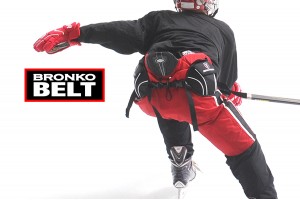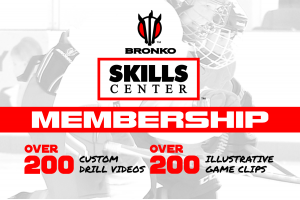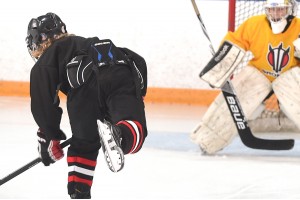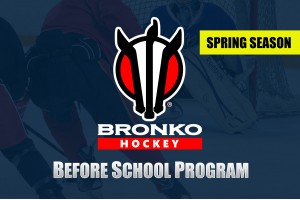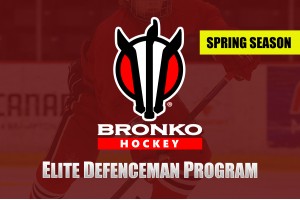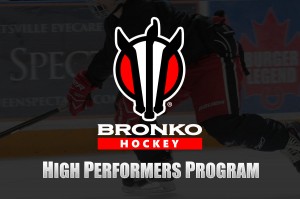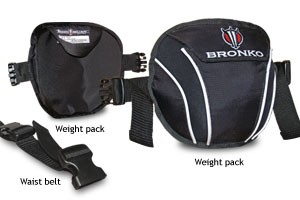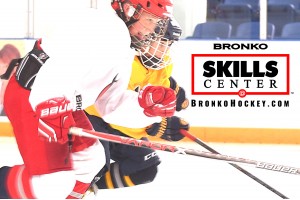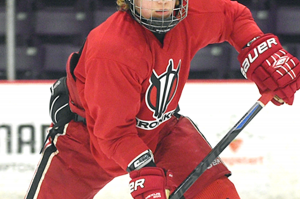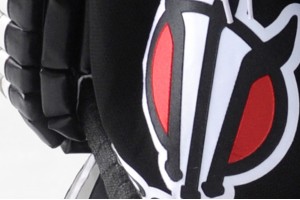The Bronko Belt’s patented design distributes an adjustable amount of training weight evenly around a player’s center of gravity without compromising that player’s ability to skate, shoot or stickhandle normally. The low profile fit of the Belt means players and teams can train with the Belt in a wide range of drills. Depending on the type of training done, players can experience improvement in a number of areas that directly impact their performance on the ice.

►Single leg strength and deep knee bend
Leg strength—single leg strength, in particular—plays a large role in the development of proper stride mechanics. For young players in particular, inadequate leg strength is a major reason why some players struggle to develop proper stride mechanics. The Bronko Belt RTI helps players develop functional single leg strength in two ways.
First, because the Belt positions the training weight evenly on the hips, the training weight exerts a downward force that can help develop leg strength and endurance in the Glide Leg, the leg upon which a player loads his body weight while gliding. Strength in this leg is what allows a player to achieve the deep knee bend position required for long, powerful strides and maintain that position longer into a shift. When a player lacks the strength to support and maintain his body weight in this position, the Glide Leg straightens resulting in shorter, less powerful strides and reduced speed. You can see this happen towards the end of a shift as fatigue starts to set in. The Belt can help build the leg srength to maintain this position longer.
Second, the Belt helps build functional, sport-specific strength in the Drive Leg, the leg that provides the push in each stride. Players must use their edges aggressively to overcome the added resistance and learn to maximize force application appropriate to the direction of travel. Players not only develop better leg strength but they learn to express that strength in a coordinated manner to produce skating movements. Because they have the freedom to perform any skating movement while wearing the belt, players can train not only the leg and core muscles used for long strides but also those used during tight turns, stopping, crossing over etc.
"For skating, developing players should work on two-leg and one-leg strength training. When players strengthen their legs at a young age, this increases their chances of learning to skate correctly. Skating and leg strength (especially single-leg strength) are synergistic, so they should be developed at the same age. But training should be fun."
Laura Stamm, "Laura Stamm's Power Skating," page 250. Link to book.
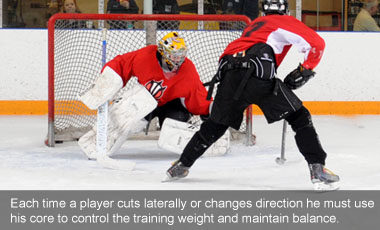
►Core strength, dynamic balance and stability
Players using the Bronko Belt are forced to use their core and stabilizer muscles to support and control the training weight each time they stride or change direction. Players learn to make small adjustments to control the weight as they perform the full range of skating skills at practice. This dynamic balance is critical for proper edge control and efficient transfer of power during each skating maneuver. Players wearing the Belt learn to control the training weight by minimizing unnecessary movements while skating. They tend to adopt a wider stance and deeper knee bend which are important factors in improved stability.
"Dynamic one-leg strength and balance is the common bond to hockey performance and an important foundation upon which all other training builds. The better an athlete's single leg balance, the more he is prepared for advance workouts. The most important feats of strength and balance will be required in unstable situations such as driving through traffic to the net or cycling in the corner and protecting the puck under tight check."
Peter Twist, "Complete Conditioning for Hockey," page 105. Link to book.
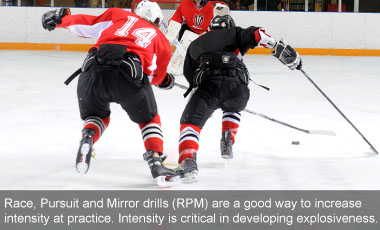
►Powerful leg drive for acceleration and agility
Once players have adequate balance/edge control and single leg strength, they can improve their explosive power by training to move the training weight more quickly. Strength in hockey is more valuable when it can be expressed quickly. Increased power is achieved when players train to move at maximum speed.
Resisted sprint training is a training method used by athletes in many sports to improve acceleration and explosiveness. The belt allows hockey players to benefit from this type of training in a sport-specific way. Players can execute the full range of skating and puckhandling maneuvers while wearing the Belt, meaning they can perform drills to improve multidirectional acceleration including lateral movement and speed in transition. Players develop muscle strength and power that can be expressed in a coordinated manner to produce skating speed. Drills that add a competitive element to training can increase the intensity level and push players to reach high levels of performance.
“Although research shows that sled training may not improve the athlete’s ability to run at top speed, it will help the athlete get faster. Remember, sport is about acceleration, not top speed. Very few team sport athletes ever get to what track coaches like to call absolute speed mechanics. The weighted sled may be the most underrated tool for speed development due to our misinterpretation and misunderstanding of the research and terminology surrounding speed development." Mike Boyle, "Using a Weighted Sled for Acceleration Improvement." Link to article.

►Increased intensity for anaerobic endurance
The Belt can help increase the intensity of drills which makes it a valuable tool for anerobic conditioning. Being able to recover quckly from high intensity shifts is important because players need to be able to compete as hard at the end of games as at the beginning.
To make conditioning drills as game like as possible coaches should include multi-directional acceleration and deceleration as part of training. The Belt adds an element of difficulty to these drills without restricting a player's full range of motion. Strength endurance in the muscles needed for a wide range skating skills can be developed.
“Overload skating is a great way to achieve anaerobic conditioning, as well as stride length, stride power and dynamic balance. Attempting maximum speed during resisted skating drills will help players maintain a positive angle from the hip to the ice, achieve a strong leg drive, and use the skate edges to generate maximum force. The key to all anaerobic training is intensity – skating under a resisted condition can help maximize this.” Peter Twist, "Anaerobic Conditioning: Overload Skating." Link to article.
Note: The quotes included in this post do not represent endorsement of any product by their authors. The quotes are included to provide context to readers based on each authors' experience and expertise on the specific aspects of training being discussed. Links and references to the sources of the material are provided in each case where possible.

